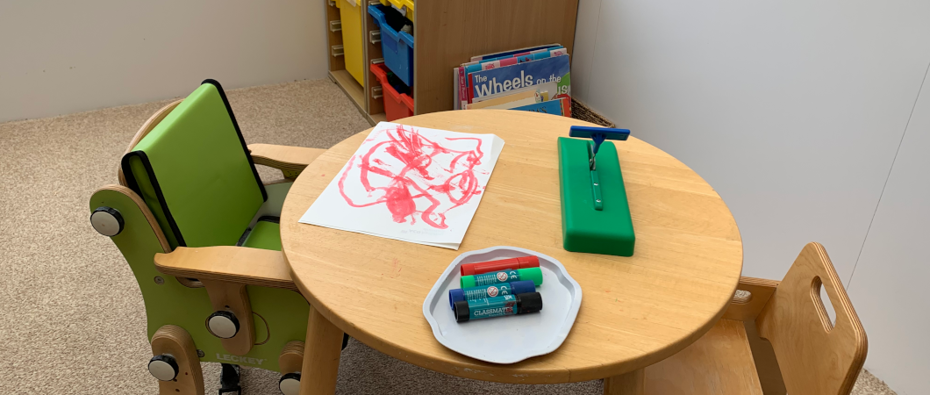
Enabling Environment
- Reduce language and questions.
- Allow the child time to process instructions (ten seconds).
- Actively use visuals to support communication (see the visual section below).
- Avoid idioms (e.g., “pull your socks up”, or “it’s raining cats and dogs”).
- Say what you want rather than what you do not want.
- Be clear if you are giving a choice or instruction.
- Make sure your communication is developmentally appropriate to the child.
- Practitioners should give individual instructions where needed, first ensuring they have gained the child’s attention.
- Use scripts and predictable language for routine activities and transitions (e.g. “First… then…” “It’s time to…” “5,4,3,2,1 finished”).
- Give clear instructions in the order the child needs to do it (e.g., “coat on the outside”).
- Observe to respond to children’s communication attempts.
- Think carefully about what the child is communicating through their behaviour, and respond appropriately.
- Respond appropriately to a child’s requests and protests.
- Value and look for meaning in all attempts to communicate.
- Respond to the child’s preferred means of communication.
- Respond to and support the child to use augmentative and alternative communication.
- Ensure the child is given motivating and meaningful ways to make choices (e.g. objects of reference, symbols, choosing boards, and verbal choices).
Visuals can be used to support understanding and engagement in routine and new situations. Visuals can be useful as they support understanding of the spoken words which “disappear” once they have been spoken, whilst visuals are kept accessible directing and holding attention and allowing more time to process. The consistent use of visuals can help children to understand a situation or communication and help to reduce anxiety. Using the same visuals at home and setting is preferable.
Types of visuals:
- objects of reference
- symbols or photos
- first then boards
- visual timetables (for group or individual child)
- visual sequences
- choosing boards
- Social Stories.
- Avoid insisting children make eye contact, this can be difficult for some children.
- Support the child to play alongside other children offering support, reassurance and reducing challenges.
- Support them to engage with peers with basic turn-taking activities.
- Support peers to understand the child’s communication and interaction attempts or to join activities of interest.
- Provide small group activities to build interaction, communication, and social skills.
- Observe to respond to children’s communication attempts.
- Follow the child’s lead and imitate the child (intensive interaction).
- Use simple repetitive language in play and songs.
- Play people games.
- Create motivating and meaningful opportunities to communicate.
- Create predictable routines for the child to communicate (e.g., Ready Steady Go activities).
- Provide activities to support the development of joint attention (this may include “Bucket time” and attention-building activities).
- Create opportunities to engage in turn-taking activities in play.
- Practitioners understand the individual needs of the child and understand their profile, including specific interests and areas of strength and needs.
- Where a setting supports an autistic child the setting CPD helps practitioners to understand the potential impact on a child’s social communication, sensory, emotional regulation and learning needs.
- Value children’s self-chosen activities, schemas and “special interests”.
- Experiences, activities, and resources are provided for the child to engage in and build upon their interests.
- Practitioners sensitively build upon children’s interests and skills.
- Identiplay is used to support the child.
- Learning is planned to reflect the child’s interests.
We all process sensory experiences differently and some have more pronounced responses to sensory experiences, this is more common for autistic children (and adults). Some children may experience sensory input more intensely (hypersensitive) and may find these unpleasant and therefore avoid (e.g., noise). Other children may be under-sensitive to some or all sensory experiences and therefore seek these sensations out e.g., jumping to get the sensory feedback.
Some useful strategies:
- Practitioners are aware of individual children’s sensory needs.
- The setting seeks to explore and reflect on a child’s sensory needs.
- Practitioners are mindful and responsive to a child’s sensory needs.
- Practitioners understand that children’s behaviour can be in response to sensory seeking, avoidance and or being overwhelmed by multiple sensory experiences, and practitioners are responsive to this.
- Provide activities and experiences that respond to children’s sensory-seeking behaviours (e.g., messy play for a child who seeks wet textures, movement activities such as bouncing on a ball for children seeking proprioceptive input).
- Provide a quiet area with limited visual distractions for children where they can go when they are experiencing sensory overload, this could be a corner or a tent.
- When trying to engage with the child consider the competing sensory input and whether there are times the child needs access to a quieter environment or space to engage.
- Consider noise levels when setting out activities (e.g., putting a fleece blanket on the table reduces the noise of banging bricks).
- Adapt activities in response to children’s sensory behaviour (e.g., you may observe a child swiping a cluttered table of puzzles but present one puzzle on an individual tray this may reduce the sensory impact and make the task seem more manageable).
- Practitioners support children in using resources provided to support individual sensory needs (e.g., ear defenders).

